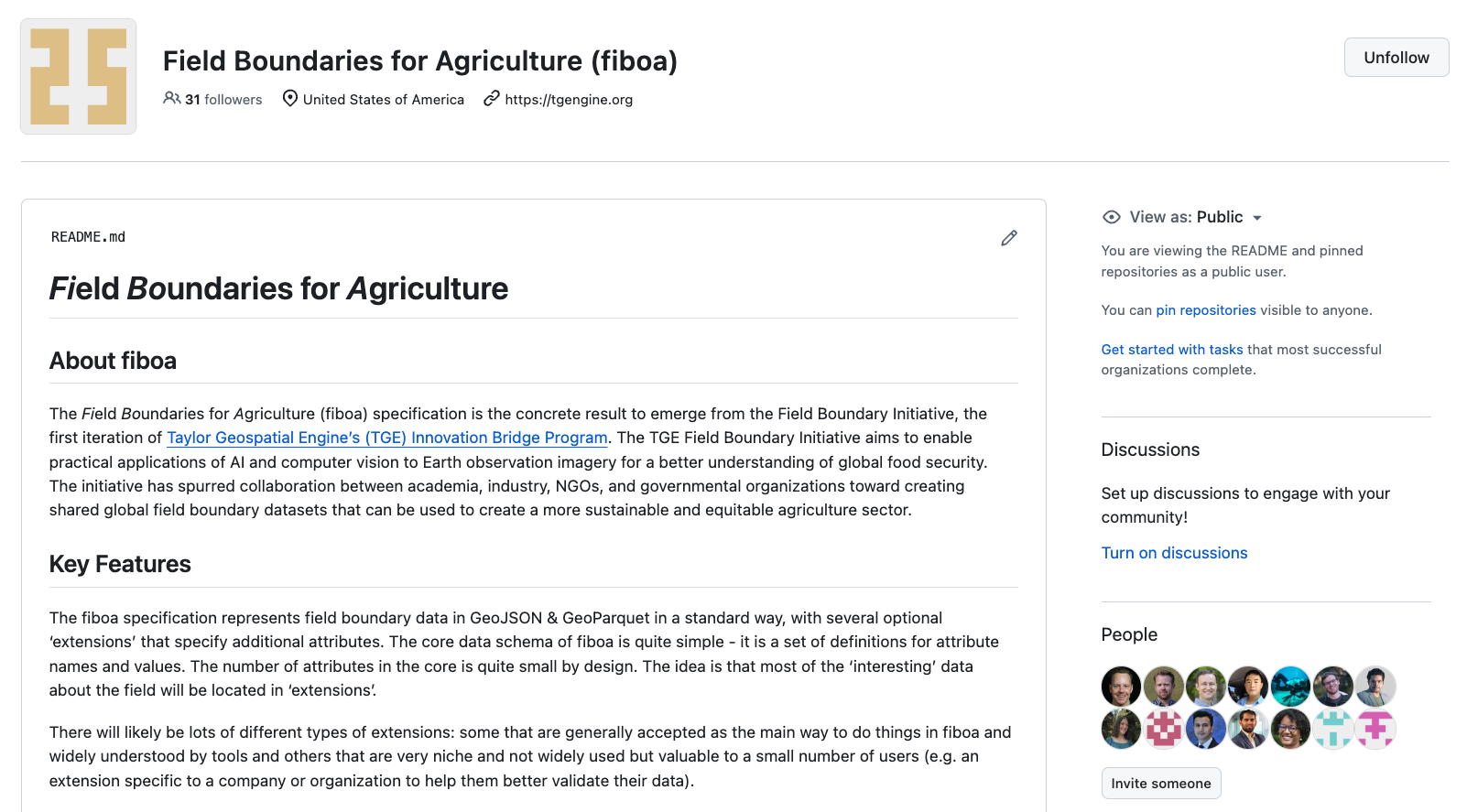Introducing fiboa
We are excited to announce fiboa (Field Boundaries for Agriculture), a new project we’re collaborating on with the Taylor Geospatial Engine (TGE) focused on improving interoperability of farm field boundary data and other associated agriculture data. We’re excited about the enormous potential of this project, and we’ve already started a community of people who share our excitement.
fiboa is the first concrete result from the TGE Field Boundary Initiative, which aims to enable practical applications of AI and computer vision to Earth observation imagery for a better understanding of global food security. The initiative has spurred collaboration between academia, industry, NGOs, and governmental organizations toward creating shared global field boundary datasets that can be used to create a more sustainable and equitable agriculture sector.
We worked with TGE to launch this effort in February at a workshop in St. Louis that brought together almost 20 different organizations including Microsoft, Google, Bayer, and the World Resources Institute. At the end of the two days, we shipped version 0.1 of the fiboa core specification (we have continued to work on it and it is now at version 0.2), which provides a common language for any dataset to describe field boundaries and a way to add extensions to add ancillary data and metadata about fields.

Why a farm field boundary data schema?
We recently wrote about how commonly used data schemas are essential to enable data interoperability and collaboration on complex global challenges. fiboa is our first effort to put that thinking into practice by creating a common schema for farm field boundaries.
Farm fields are a foundational unit of production for any agricultural supply chain. Efforts to improve agricultural practices such as the European Union’s deforestation regulation (EUDR) will only succeed if we have reliable information about where food comes from, and many of the world’s most common food products like wheat, maize, potatoes, and soybeans originate from farm fields. Despite this, there is not yet a commonly accepted data schema to describe farm fields.
By convening a community of practitioners who work with field data, we hope to solve this problem quickly and practically, creating a shared language that will foster and accelerate innovation among everyone working to understand agricultural supply chains. A common schema will enable seamless exchange of data among a variety of tools rather than requiring data engineers to create mappings from one dataset to another.
Why now?
We’re doing this now because we are at a point when it is possible to create and distribute planetary-scale field boundary data much more quickly and cheaply than ever before. Many field boundaries around the world can be derived by applying machine learning (ML) techniques to freely available satellite imagery. TGE has funded research teams led by Dr. Hannah Kerner at Arizona State University and Dr. Nathan Jacobs at Washington University in St. Louis to accelerate research in this area and determine if ML-derived data can be commercially viable.
Simultaneously, advances in cloud-native vector data formats like GeoParquet also make it trivial to share the large volumes of field boundary data that can be produced from satellite imagery. We will be working with researchers who produce field boundary data to get it into the fiboa specification and then publish it in cloud-native formats on Source Cooperative.
How will this work?
Though we don’t have a formally published set of collaboration principles, this declaration from the Internet Engineering Task Force (IETF) is a good summary of our approach:
“We reject: kings, presidents, and voting. We believe in: rough consensus and running code.”
We place higher value on practical, working solutions and the broad agreement of participants than trying to vote for the perfect data schema. The principles that guide us are similar to the Core Principles we came up with for the SpatioTemporal Asset Catalog, summarized here:
- Creation and evolution of specs in Github JSON + REST + HTTP at the core.
- Small reusable pieces loosely coupled.
- Focus on the developer.
- Working code required.
- Design for scale.
It is in this spirit that fiboa will be built in public with many members of our community throughout the coming year and beyond. While fiboa is merely a metadata specification, we see it as the basis for a robust architecture of participation that will allow many people and institutions to contribute the specifications, tools, and data that we need to improve our understanding of the global agricultural sector. For a deeper dive on what we’re up to see fiboa: Core Specification & Extensions and fiboa: The Ecosystem.
If you’re interested in getting involved, please feel free to contribute via the fiboa GitHub, join our Slack, or email us at hello@cloudnativegeo.org. We also invite you to a live tutorial presented by Matthias Mohr on Thursday April 25 at 12 pm ET and on Monday, April 29 at 11 am EST. These sessions introduce you to the fiboa CLI and demonstrate how to create a fiboa extension, and the recordings are now available at github.com/fiboa/tutorials/.
Our blog is open source. You can suggest edits on GitHub.